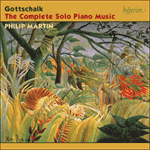
Welcome to Hyperion Records, an independent British classical label devoted to presenting high-quality recordings of music of all styles and from all periods from the twelfth century to the twenty-first.
Hyperion offers both CDs, and downloads in a number of formats. The site is also available in several languages.
Please use the dropdown buttons to set your preferred options, or use the checkbox to accept the defaults.

The Dodworth’s Hall concerts ran from 20 December 1855 to 7 June 1856. Gottschalk recorded in Notes of a Pianist that he introduced Le chant du soldat at the first of these. S Frederick Starr states that it was first heard as part of the programme for the fifth recital, which included the appearance of assisting pianist Karl Wels and ‘the prodigiously talented Welsh harpist Aptomas’. The theme and variations contain the full Gottschalk arsenal—charm, melodic appeal, delicate filigree runs, bravura octaves, Chopinesque configurations, nostalgic and forthright by turns—with his habitual élégante, scintellante and martellato strepitoso requests, together with one that this writer has never previously encountered: allontandosi, which appears eight bars before the coda.
The piece is dedicated ‘à mon ami George Henriques Esq. de New York’, a lawyer who had known the Gottschalk family in New Orleans twenty years earlier. When Gottschalk returned from New Orleans early in 1855, it was Henriques and his family who opened up their West 14th Street home to the pianist and treated him like a son.
from notes by Jeremy Nicholas © 2004
Les concerts de Dodworth’s Hall se déroulèrent du 20 décembre 1855 au 7 juin 1856. Gottschalk soulignait dans Notes d’un Pianiste qu’il présenta Le chant du soldat lors du premier de ces concerts. S. Frederick Starr affirme qu’il fut exécuté au sein du programme du cinquième récital qui comprenait l’apparition d’un assistant pianiste Karl Wels et de la «harpiste galloise au talent prodigieux, Aptomas». Le thème et variations contient tout l’arsenal de Gottschalk—charme, séduction mélodique, traits fluides en filigrane, des octaves de bravoure. Des figurations chopinesques, tour à tour nostalgiques et audacieuses—avec ses exigences habituelles d’élégance, scintillante et martellato strepitoso ainsi qu’une autre que je n’ai jamais rencontré auparavant, allontandosi, qui apparaît huit mesures avant la coda.
Cette œuvre est dédiée «A mon ami George Henriques Esq. De New York», un avocat qui avait fait la connaissance de la famille Gottschalk vingt ans auparavant à la Nouvelle-Orléans. Quand Gottschalk revint à la Nouvelle-Orléans en 1855, ce fut Henriques et sa famille qui lui ouvrirent les portes de leur demeure, West 14th Street, et le traitèrent comme leur fils.
extrait des notes rédigées par Jeremy Nicholas © 2004
Français: Isabelle Battioni
Die Konzerte in Dodworth’s Hall liefen vom 20. Dezember 1855 bis zum 7. Juni 1856. In Notes of a Pianist [Notizen eines Pianisten] hielt Gottschalk fest, dass er Le chant du soldat [Das Lied des Soldaten] in dem ersten Konzert gespielt habe. S. Frederick Starr hingegen gibt an, dass es in dem fünften Konzert zum ersten Mal erklang, in dem außerdem der Pianist Karl Wels sowie „der außerordentlich begabte walisische Harfenist Aptomas“ auftraten. In dem Thema und den Variationen ist das volle Arsenal der Stilmittel Gottschalks enthalten—Charme, melodische Grazie, feingliederige Läufe, bravouröse Oktaven, Chopinsche Verzierungen, abwechselnd sehnsuchtsvoll und unverblümt—wie auch seine gewöhnlichen Markierungen: élégante, scintellante und martellato strepitoso. Acht Takte vor der Coda kommt jedoch eine völlig neue Anweisung: allontandosi.
Das Stück ist „meinem Freund, Herrn George Henriques aus New York“ gewidmet, ein Rechtsanwalt, der die Familie Gottschalk bereits zwanzig Jahre zuvor in New Orleans kennengelernt hatte. Als Gottschalk 1855 aus New Orleans wiederkehrte, hießen Henriques und seine Familie ihn in ihrem Hause in der West 14th Street willkommen und nahmen den Pianisten wie ihren eigenen Sohn auf.
aus dem Begleittext von Jeremy Nicholas © 2004
Deutsch: Viola Scheffel
 Gottschalk: The Complete Solo Piano Music Gottschalk: The Complete Solo Piano MusicWith his idiomatic and graceful style, pianist Philip Martin has established himself as the foremost exponent of Gottschalk. The composer had a unique spontaneity and individuality which Martin’s performances bring vividly to the fore. The complet ...» More |

